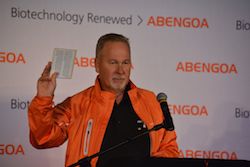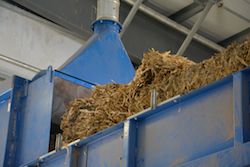 Who better to learn about how Abengoa’s cellulosic ethanol plant works then from Plant Manager Danny Allison. He explained to the standing room only crowd during Abengoa’s grand opening celebration, how the state-of-the-art biorefinery will produce cellulosic ethanol, bioenergy and other byproducts including ash that farmers can use as organic fertilizer on their fields.
Who better to learn about how Abengoa’s cellulosic ethanol plant works then from Plant Manager Danny Allison. He explained to the standing room only crowd during Abengoa’s grand opening celebration, how the state-of-the-art biorefinery will produce cellulosic ethanol, bioenergy and other byproducts including ash that farmers can use as organic fertilizer on their fields.
Here is how the plant works:
Biomass: biomass harvested from local growers corn and wheat fields by Pacific Ag is delivered to the Abengoa plant to begin the ethanol production process. Each bale is quality tested for moisture, dust and other contaminants that could hinder the conversion process.
Biomass In-take Lines: six-packs of residue travel down conveyor belts to be separated into single bales by a singulator. Each bale goes through a chopper, cutting the biomass  into easy-to-handle materials and then fed into a grinder.
into easy-to-handle materials and then fed into a grinder.
Pre-Treatment: The pre-treatment process is where the starch is converted to sugars using Abengoa’s proprietary enzymes. From there fermentation occurs suing industrial yeast to convert the sugar to alcohol. At the end of fermentation, the liquid, now 5 percent alcohol, goes into a 1.3 million gallon tank, or beer well.
Distillation System and Ethanol Holding Tanks: All solids, water vapor and alcohol are removed. The now 95 percent pure ethanol moves to a column while the remaining 5 percent goes to the bottom for reprocessing and reclamation. After all impurities and water are removed, the finished ethanol is pumped to half-million storage tanks and ready for shipment by rail or truck.
Electrical Power Station: The Abengoa bioenergy plant will also produce up to 21MW of renewable electricity used to power the plant. Excess electricity will be fed to the grid for city use.
Learn more about the process by listening to Danny Allison’s remarks: Danny Allison Remarks

